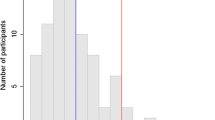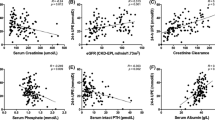Abstract
The purpose of this study is to derive approximate estimates of ion-activity products of CaOx (APCaOx) and CaP (APCaP) useful for spot urine or other less well defined short-term urine collections. In accordance with previously applied and described principles for estimating ion-activity products, the intention was to derive simplified estimates of AP(CaOx)CONC and AP(CaP)CONC by using urine concentrations of the most important determinants of APCaOx and APCaP. A comparison thus was made between estimates derived in that manner and AP(CaOx) index and AP(CaP) index obtained from calculations based on analysis of 24 h urine samples. The best fit between estimates of AP(CaOx) index in 24 h urine and AP(CaOx) indexCONC was obtained with the following formula (r = 0.99; p = 0.0000): \({\text{AP(CaOx)index}}_{\text{CONC}} = \frac{{2.09 \times c{Ca}^{0.84} \times c{Ox} }}{{c{Cit}^{0.22} \times c{Mg}^{0.12}}}. \) The corresponding formula for AP (CaP) indexCONC was derived from comparison with the corresponding calculations of AP(CaP) index in 24 h urine (r = 0.91; p = 0.0000): \({\text{AP(CaP)index}}_{\text{CONC}} = \frac{{0.432 \times c{Ca}^{1.07} \times c{P}^{0.70} \times ({pH} - 4.5)^{6.8}}}{{c{Cit}^{0.20} }}. \) The proposed simplified formulas enable calculation of approximate estimates of APCaOx and APCaP in spot-urine samples or any kind of urine collection for which duration of the collection period is less well known and by using the concentrations (c) of the variables in mmol/L in the two formulas.


Similar content being viewed by others
References
Tiselius HG (1996) Solution chemistry of supersaturation. In: Coe FL, Favus MJ, Pak CYC, Parks JH, Preminger GM (eds) Kidney stones: medical and surgical management. Lippincott-Raven Publishers, Philadelphia, pp 33–64
Tiselius H-G, Alken P, Buck C, Gallucci M, Knoll T, Sarica K, Türk C (2009) EAU Guidelines on urolithiasis. In: European Association of Urology Guideline Office. Arnhem, The Netherlands. ISBN/EAN 978-90-79754-09-0
Tiselius HG, Larsson L (1981) Biochemical evaluation of patients with urolithiasis. Eur Urol 7:31–34
Semins MJ, Matlaga BR (2011) Blood and urinary tests in stone formers. In: Rao PN, Preminger GM, Kavanagh JP (eds) Urinary Tract Stone Disease. Springer Verlag, London, pp 369–374
Tiselius HG (1991) Aspects on estimation of the risk of calcium oxalate crystallization in urine. Urol Int 47:255–259
Tiselius HG (1982) An improved method for the routine biochemical evaluation of patients with recurrent calcium oxalate stone disease. Clin Chim Acta 122:409–418
Tiselius HG (1989) Standardized estimate of the ion-activity product of calcium oxalate in urine from renal stone formers. Eur Urol 16:48–50
Tiselius HG (1984) A simplified estimate of the ion-activity product of calcium phosphate in urine. Eur Urol 10:191–195
Tiselius HG (1997) Estimated levels of supersaturation with calcium phosphate and calcium oxalate in the distal tubule. Urol Res 25:153–159
Tiselius HG (2011) A hypothesis of calcium stone formation: an interpretation of stone research during the past decades. Urol Res 39:231–243
Ahlstrand C, Larsson L, Tiselius HG (1984) Variations in urine composition during the day in patients with calcium oxalate stone disease. J Urol 131:77–81
Hesse A, Bach D (1982) Circadianer Rythmus harnstein-relevanter Parameters. In: Breueer H, Büttner H, Stamm D (eds) Klinische Chemie in Einzeldarstellungen Band 5: Harnsteine. Pathobiochemie und klinisch-chemcishe. Georg Thieme Verlag, Stuttgart, New York
Strohmaier WL, Hoelz KJ, Bichler KH (1997) Spot urine samples for the metabolic evaluation of urolithiasis patients. Eur Urol 32:294–300
Hong YH, Dublin N, Razack AH, Mohd MA, Husain R (2010) Twenty-four hour and spot urine metabolic evaluations: correlations versus agreements. Urology 75:1294–1298
Ogawa Y, Yonou H, Hokama S, Oda M, Morozumi M, Sugaya K (2003) Urinary saturation and risk factors for calcium oxalate stone disease based on spot and 24-hour urine specimens. Front Biosci 8:167–176
Werness PG, Brown CM, Smith LH, Finlayson B (1985) EQUIL2: a basic computer program for calculation of urinary saturation. J Urol 134:1242–1244
Robertson WG (1969) Measurement of ionized calcium in biological fluids. Clin Chim Acta 24:149–157
Finlayson B (1977) Calcium stones: Some physical and clinical aspects. In: David DS (ed) Calcium metabolism in renal failure and nephrolithiasis. Wiley, New York, pp 337–382
Ashby R, Györy AZ (1997) A thermodynamic equilibrium model for calcium salt urolithiasis: clinical application. Exp Nephrol 5:246–252
Rodgers AL, Allie-Hamdulay S, Jackson G, Tiselius HG (2011) Simulating calcium salt precipitation in the nephron using chemical speciation. Urol Res 39:245–251
Conflict of interest
None.
Author information
Authors and Affiliations
Corresponding author
Rights and permissions
About this article
Cite this article
Tiselius, HG. A proposed method for approximate estimates of the ion-activity products of calcium oxalate and calcium phosphate in spot-urine samples or in urine samples collected during less well defined periods of time. Urolithiasis 41, 105–109 (2013). https://doi.org/10.1007/s00240-012-0524-9
Received:
Accepted:
Published:
Issue Date:
DOI: https://doi.org/10.1007/s00240-012-0524-9




